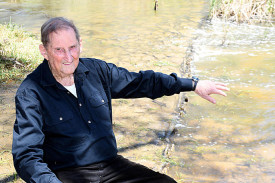Rural
16 November, 2024
“If you don’t know where you’ve been, how do you know where you’re going?” A history of the remarkable Wimmera water ways
Wimmera historian Bob McIlvena 90, who has spent many years researching the largest open channel water system and river supply in the world…including the former Wimmera Mallee Channel system.

Mr McIlvena started working with the State Rivers and Water Commission in the early 1960’s and worked with the organisation for well over 30 years, as a construction worker maintaining and constructing regulators, building bridges and distribution equipment- eventually retiring in 1993. Being the longest lasting and oldest water authority in Australia, the system was originally completed in 1905, and was only progressively decommissioned when the system was replaced by the new pipeline system in the 2000’s.
Mr McIlvena said the old channel and river/creek system included 16,000 kilometres of open channels, 24,000 dams, 3,000 hectares of irrigation properties and 50 town reservoirs throughout the region.
It was the lifeblood of the region, despite substantial inefficiencies, with the system losing up to 90 per cent of the water distributed to the north through seepage and evaporation.
“Remarkably all of the water storages were constructed by hand with horse and drays and manpower including the storages…a mammoth task, but imperative for the lives of settlers and their livestock, particularly in drought years,” Mr McIlvena said.
“Image the task of finding levels across the countryside and digging channels manually, so they ran the water effectively as they meandered across the countryside around hills and over depressions. You can’t run water up a hill so the surveyors had to find routes that ran water across the vast region,” he said.
According to Mr McIlvena, this history needs to be recorded for future generations and in his words… “If you don’t know where you’ve been, how do you know where you’re going”.
Working with Wimmera Mallee management agencies, researching countless newspaper reports and documents, Mr McIlvena has recorded a vast amount of information on the history of the system for perpetuity.
Starting in this issue and continuing over the forthcoming months Wimmera Mallee News will publish this history, which will eventuate into a book.
Read More: Waters of the Wimmera
